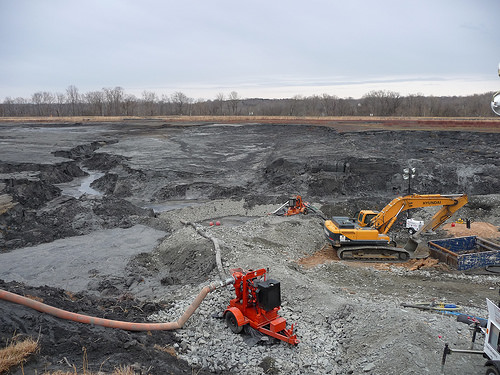The U.S. Environmental Protection Agency (EPA) on Friday announced the first federal regulations for disposal of ‘coal ash’—toxic residual waste from coal-fired power plants—in a long-awaited move that critics blasted as toothless and insufficient.
“For the thousands of citizens whose groundwater is no longer safe for consumption due to leaching ponds or whose air is contaminated by fugitive dust, failing to regulate coal ash as hazardous is a slap in the face.”
—Amy Adams, Appalachian Voices
Environmentalists said the new rules, which categorize coal ash as solid, not hazardous, waste, don’t go far enough to shield those who are directlyimpacted by the 140 million tons of ash pollution produced annually by America’s coal plants.
“For decades, coal ash has been dumped in our water and blown in our communities, without state or federal oversight,” Louisville-area residents Kathy Little, Mark Romines, and Wallace McMullen said in a statement issued by the Sierra Club. “While the EPA and the Obama Administration have taken an important first step by introducing this first-ever, long-overdue rule to help protect our homes from the toxic by-product of our dirtiest energy source, the standard does not go far enough to protect our families from coal ash pollution.”
At a press conference, EPA Administrator Gina McCarthy said: “EPA is taking action to protect our communities from the risk of mismanaged coal ash disposal units, and putting in place safeguards to help prevent the next catastrophic coal ash impoundment failure, which can cost millions for local businesses, communities and states.”
Specifically, the new rules call for:
- The (proper) closure of surface impoundments and landfills that fail to meet engineering and structural standards and will no longer receive coal ash;
- Regular inspections of the structural safety of surface impoundments that remain open;
- Restrictions on the location of new surface impoundments and landfills so that they cannot be built in sensitive areas such as wetlands and earthquake zones;
- Groundwater monitoring, immediate cleanup of contamination, and closure of unlined surface impoundments that are polluting groundwater.
Environmentalists like Eric Schaeffer of the Environmental Integrity Project criticized the standards as “minimal, vague, and unenforceable.”
In particular, groups expressed concern that the EPA’s rules do not address ash storage sites at plants that have been closed and essentially rely on the industry to police itself without much government oversight.
“[T]here are glaring flaws in the EPA’s approach,” said attorney Frank Holleman of the Southern Environmental Law Center. “Most problematically, the absence of federal oversight and enforcement means that any meaningful protective action will continue to fall to our states and local communities. In recent years our states have failed to adequately address the widespread threat of coal ash, and we are concerned that state decision-makers will not do their part in protecting waterways and the health of citizens. We have seen how this issue plays out in North Carolina, where the state has not done enough to address Duke Energy’s irresponsible handling of coal ash, despite the disastrous Dan River spill earlier this year.”
Public health advocates were also outraged that the EPA failed to classify coal ash as hazardous waste, despite the fact that it can contain contain substances like chromium, arsenic, mercury, and lead.
“For the thousands of citizens whose groundwater is no longer safe for consumption due to leaching ponds or whose air is contaminated by fugitive dust, failing to regulate coal ash as hazardous is a slap in the face,” said Amy Adams, North Carolina campaign coordinator for Appalachian Voices.
“Today’s rule doesn’t prevent more tragic spills like the ones we are still trying to clean up in North Carolina and Tennessee,” echoed Lisa Evans, an attorney with Earthjustice, whichsued the EPA over coal ash in 2012 on behalf of about a dozen environmental and public health groups as well as a Native American tribe. “And it won’t stop the slower moving disaster that is unfolding for communities around the country, as leaky coal ash ponds and dumps poison water.”
Esther Calhoun, who lives near a coal ash dump in Uniontown, Alabama, put it even more starkly: “It seems like the EPA doesn’t give a damn about people.”


